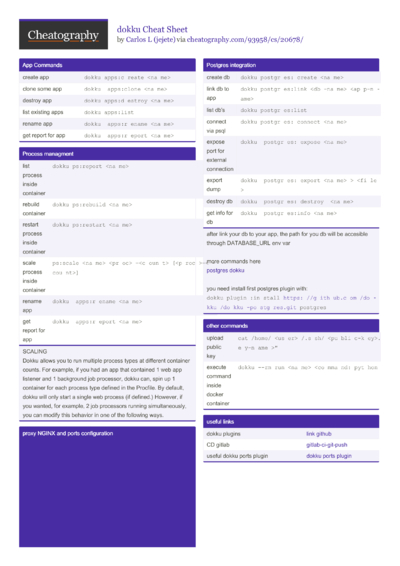- Agency transactions. Your transaction. Appointment; walk-in.
- Find out how to do stuff: The New MVC “CHEAT SHEET” Find out what locations are closed: Location Closures and Updates; Find out how to fix a suspension problem: Suspensions pdf Find out how to fix another kind of problem: Help, Something Went Wrong!
How to get data from your HTML forms to ASP.NET Core (using Tag Helpers).
CSHTML
Apr 25, 2013 Cheat sheet (a concise set of notes) serve as reference tool having simple, brief instructions that offers fast help. If you are a developer working with different programming languages or different versions of languages then you know the logic but might face problem of syntax because of language overflow or out of practice. Dec 04, 2020 New Jersey MVC offices keep closing. A new cheat sheet will tell you what to do and if you even have to go at all. News Local Sports High School Sports Elections USA TODAY Obituaries E-Edition Legals. E tCo re.Mvc 1.0-non- int era ctive Delete Dversion 1.0 of package Micro sof t.A spN etC ore.M vc, not prompting user for creden tials or other input dotnet remove dotnet remove package Newton sof t.Json Remove Newto nso ft.J son NuGet package from a project in the current directory dotnet remove reference lib/li b.c sproj.
The Controller
Resulting HTML
Using default ASP.NET Core MVC routing, a request to view https://<your-app-here>/example will invoke the Index method which returns ExampleIndex.cshtml (including our form).

When that form is submitted, the data will be routed to Save and the model populated with any submitted values.
The __RequestVerificationToken is automatically generated by ASP.NET and included as a hidden field. When the form is submitted this will be included in the form data and ASP.NET will validate it to ensure this is a legitimate request.
This helps ensure the form isn’t some spoof form someone has created on a different web site, pointing to your application.
CSHTML
The Razor Page (About.cshtml.cs)
Resulting HTML
Here we explicitly inform ASP.NET that this form will post back to the About page.
ASP.NET Core will then attempt to locate and invoke an OnPost method in the About page’s Page Model (About.cshtml.cs) to handle the submitted form data.
One last step...
Check your inbox and click on the link in the email to complete the signup process and start receiving the emails!
CSHTML
Model

Resulting HTML
If you provide a [Display(Name=']) its value will be used for the label, otherwise you’ll just get the name of the property itself e.g. Name.
CSHTML
Model
Resulting HTML
ASP.NET Core will infer that this should be an input of type text because the ‘Name’ property on the model is a string.
When this form is submitted the Name property on the model will be populated using the value entered in the form.

CSHTML

Model
Resulting HTML
ASP.NET Core will infer that this should be an input of type password because of the [DataType] attribute.
Alternatively you can just specify this yourself in the CSHTML markup e.g. <input asp-for='Password' type='password'/>.
When this form is submitted, Password will be populated using the value entered in the form.
CSHTML
Model
Resulting HTML
When submitted, Bio will be populated using the value entered.
Nj Mvc Cheat Sheet
CSHTML
Model
Resulting HTML
The select tag helper needs to know where to fetch its list of options from.
Unlike the asp-for attribute (which assumes everything you try to use is on the Model), you have to explicitly tell asp-items where the list is coming from. In this case, Model.Countries.
When the form is submitted Country will be set to the selected value in the dropdown list.
CSHTML
Model
Resulting HTML
Occasionally you may need to include a value in the submitted form data but not show it on the page.
You can use hidden fields for this, setting them to a value which will then be posted back when the form is submitted.
The [HiddenInput] attribute means that ASP.NET will infer this should be a hidden field.
Alternatively you can set this yourself in the CSHTML.
<input type='hidden' asp-for='ApplicationType'>
In this example the ApplicationType of ‘Online’ will be sent “up” to the client and rendered as a hidden input. When the form is subsequently submitted this value will be included in the submitted form data and the ApplicationType property on the model will be set accordingly.
CSHTML
Model
Resulting HTML
ASP.NET Core will infer that the input should be of type “checkbox” if you point it at a Boolean property on your model.
The value attribute here is a little confusing as it seems to always be true. However, there is another attribute which isn’t visible in the rendered markup called checked and this is the important one which will change depending on whether the checkbox is ticked or not.
When the form is submitted the posted form data will include a true or false and the AcceptTerms property on the model will be populated accordingly.
Because the boolean property on the model cannot be null (has to be either true or false) ASP.NET also generates validation attributes here indicating that this input is required.
This is largely irrelevant though as, even f your users don’t touch the checkbox, a false value will be posted when the form is submitted and the Model property will be set accordingly.
CSHTML
Spring Boot Cheat Sheet
Model
Resulting HTML
Radio Buttons are different to checkboxes in that they generally come in groups of two or more and you can only select on of the possible options.
In this scenario the user can select Male or Female and the Gender property on the model will be set accordingly.
One last step...
Check your inbox and click on the link in the email to complete the signup process and start receiving the emails!
Next up
Mvc Cheat Sheet
But, which flavor of ASP.NET?Driver's License Cheat Sheet
MVC vs Razor Pages - A quick comparisonNj Mvc Cheat Sheet
